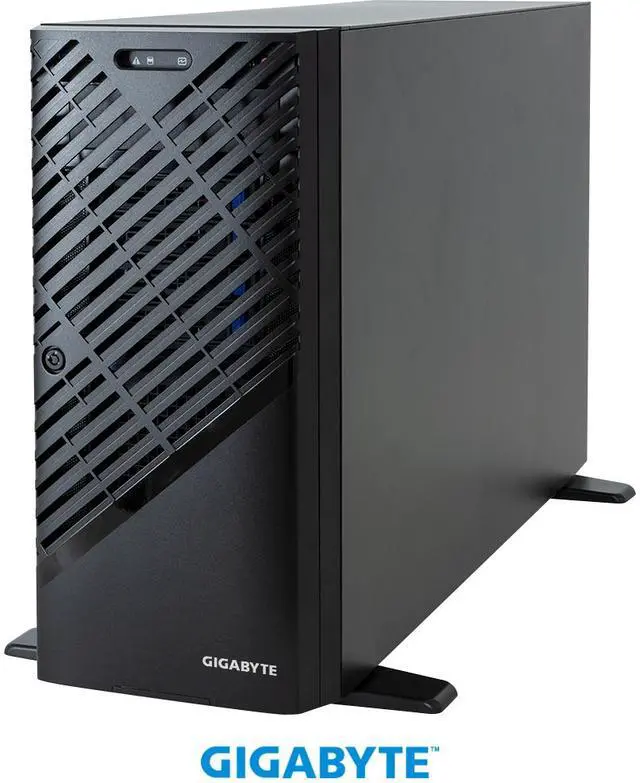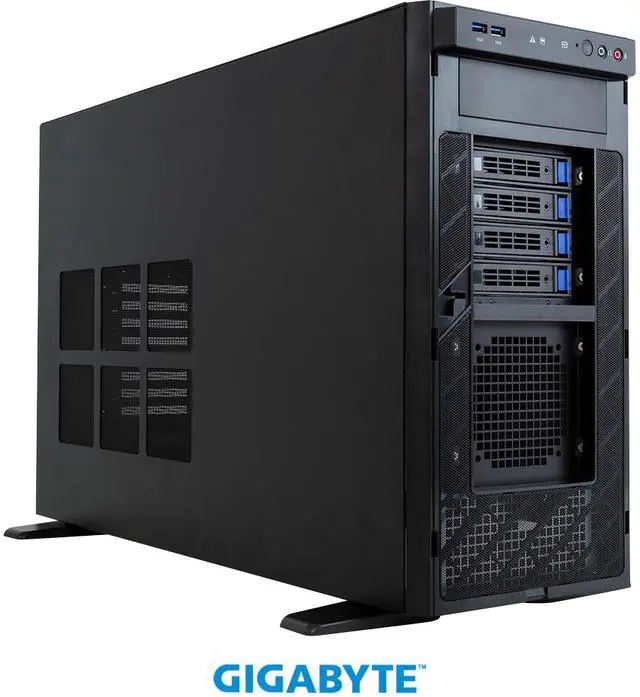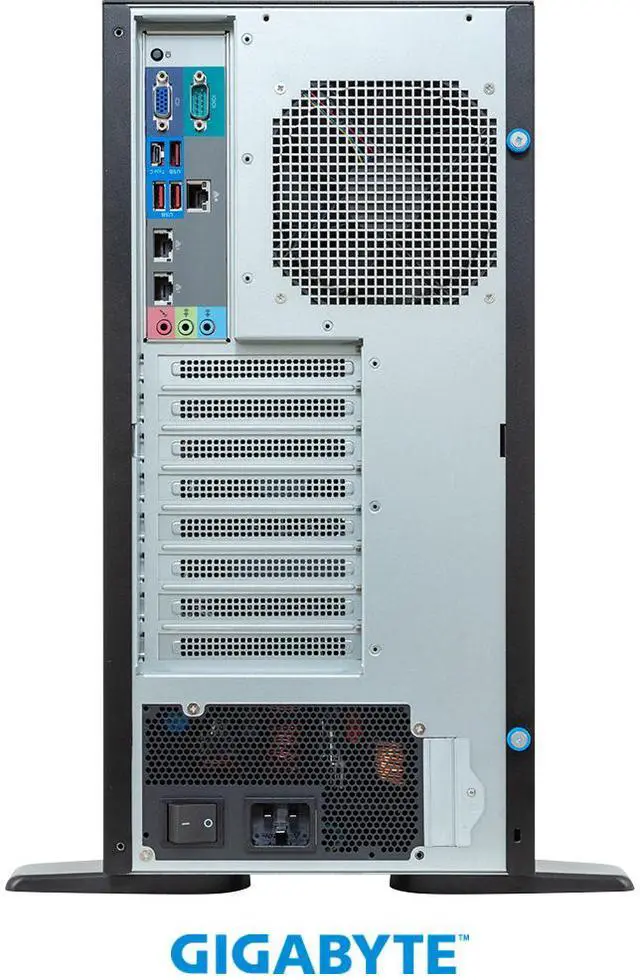
W773-W80
GPU Workstation - Intel® Xeon® W-3500/2500/3400/2400 - UP


All-New Workstation Design
Guarding Your Professional Work Needs
- Smooth edge design bold diagonal grid
- Radiating a dominant yet stable style
- Achieving a balance of functionality and aesthetics
- Large perforations enhance heat dissipation
- Iron meshes reinforcement prevents foreign objects
- Lock holes ensure information security


Insistence of Low Noise To Ensure Office Cozy Space
Installed A6000 and RTX4090 with full stress loading
under 50dB
Professional Thermal Solution
With internal airflow diversion and smart fan solution. ALL NEW W7 series ensure the balance between performance and heat dissipation.
- GIGABYTE Selected FAN module
- Large perforations enhance heat dissipation
- Airduct to diverse CPU and GPU airflow
- GSM Smart FAN Speed Control


Intel® Xeon® W-3500 & W-2500 Platform
New Expert 1S and Mainstream Workstation Solutions
Compute heavy workloads rely on the best and latest CPU technology to deliver excellent performance while the new Xeon line of processors with Intel spans from high-end to more affordable chips. Intel’s new workstation processors bring many important technological advancements that greatly benefit a wide range of disciplines from Engineering to Data Science to Media & Entertainment. PCIe 5.0 provides the highest possible throughput between CPU and GPU or SSD, including support for CXL devices. Couple that with higher CPU performance across all workloads, these new Xeon workstation CPUs can also crunch memory intensive workloads faster with DDR5 memory and AI/DL workloads have more floating point formats to choose from.

Expert 1S WorkstationIntel® Xeon® W-3500 Processors |

Mainstream WorkstationIntel® Xeon® W-2500 Processors |
|
| Chipset | Intel® W790 Chipset | |
| P-core Count | Up to 60 cores | Up to 26 cores |
| Memory Channel | 8-channel | 4-channel |
| DDR5 Memory | 1DPC @4800MT/s and 2DPC @4400MT/s | |
| Memory Capacity | Up to 4TB | Up to 2TB |
| CPU PCIe 5.0 Lanes | Up to 112 lanes | Up to 64 lanes |
| TDP | Up to 385W | Up to 250W |
W773-W80 Block Diagram

W773-W80 Product Overview


High Performance
Supports Multiple Multi-slot Accelerators
GIGABYTE Workstations have been tested and validated across a range of workloads with various computing accelerators designed to deliver high levels of performance for 3D rendering, deep learning and high-performance computing. Supporting up to 4 x Dual-slot cards or 2 x Triple-slot accelerators, the design enables content creators, data scientists, researchers, and engineers to tackle challenges that were once impossible.

NVIDIA RTX A6000

AMD Radeon PRO W7900

GIGABYTE GeForce RTX 4090 GAMING OC
AI / DL
SMB Virtual Machine
Government Science / Medical
DME
CAD
Creation
PC Scalable Display

Storage Support
Mix Drives
Plentiful NVMe and SATA Storage interface can fulfill your hot and cold data processing requirement at once.
- Onboard 2 x M.2 2280 slots (PCIe 4.0 x4) from PCH
- 4 x 3.5” / 2.5” SATA hot-swap HDD/SSD bays
- Optional 4 x 3.5” / 2.5” SATA hot-swap HDD/SSD bays
Connectivity
Dual Intel® 10GbE LAN
The Intel® X710-AT2 supports 2 x 10GbE configuration which is the foundation for workstation connectivity, providing broad interoperability, critical performance optimizations, and increased agility for Communications, Cloud, and Enterprise IT network solutions.


Hardware Security
Optional TPM 2.0 Module
For hardware-based authentication, the passwords, encryption keys, and digital certificates are stored in a TPM module to prevent unwanted users from gaining access to your data. GIGABYTE TPM modules come in either a Serial Peripheral Interface or Low Pin Count bus.
Value-added Management
GIGABYTE offers free-of-charge management applications via a specialized small processor built on the server.
GIGABYTE Management Console
For management and maintenance of a server or a small cluster, users can use the GIGABYTE Management Console, which is pre-installed on each server. Once the servers are running, IT staff can perform real-time health monitoring and management on each server through the browser-based graphical user interface. In addition, the GIGABYTE Management Console also provides:
- Support for standard IPMI specifications that allows users to integrate services into a single platform through an open interface
- Automatic event recording, which can record system behavior 30 seconds before an event occurs, making it easier to determine subsequent actions
- Integrate SAS/SATA/NVMe devices and RAID controller firmware into GIGABYTE Management Console to monitor and control Broadcom® MegaRAID adapters.

GIGABYTE Server Management (GSM)
GSM is a software suite that can manage clusters of servers simultaneously over the internet. GSM can be run on all GIGABYTE servers and has support for Windows and Linux. GSM can be downloaded from GIGABYTE website and complies with IPMI and Redfish standards. GSM includes a complete range of system management functions that includes the following utilities:
- GSM Server: A software program that provides real-time, remote control using a graphical user interface through an administrator’s computer or through a server in the cluster. The software allows ease of maintenance for large clusters of servers.
- GSM CLI: A command-line interface for monitoring and managing remotely.
- GSM Agent: A software program installed on each GIGABYTE server node that retrieves information from each system and devices through the OS, and this software integrates with GSM Server or GSM CLI.
- GSM Mobile: A mobile app for both Android and iOS that provides admins with real-time system information.
- GSM Plugin: An application program interface that allows users to use VMware vCenter for real-time monitoring and management of server clusters.


[#1] Power cords are not included with server packages. Customers are responsible for selecting appropriate power cords from the optional accessories or contacting sales for customization.
[#2] All materials provided herein are for reference only. GIGABYTE reserves the right to modify or revise the content at any time without prior notice.
[#3] Advertised performance is based on maximum theoretical interface values as specified by the respective chipset vendors or standards organizations. Actual performance may vary depending on system configuration.
[#4] All trademarks and logos are the property of their respective owners.











